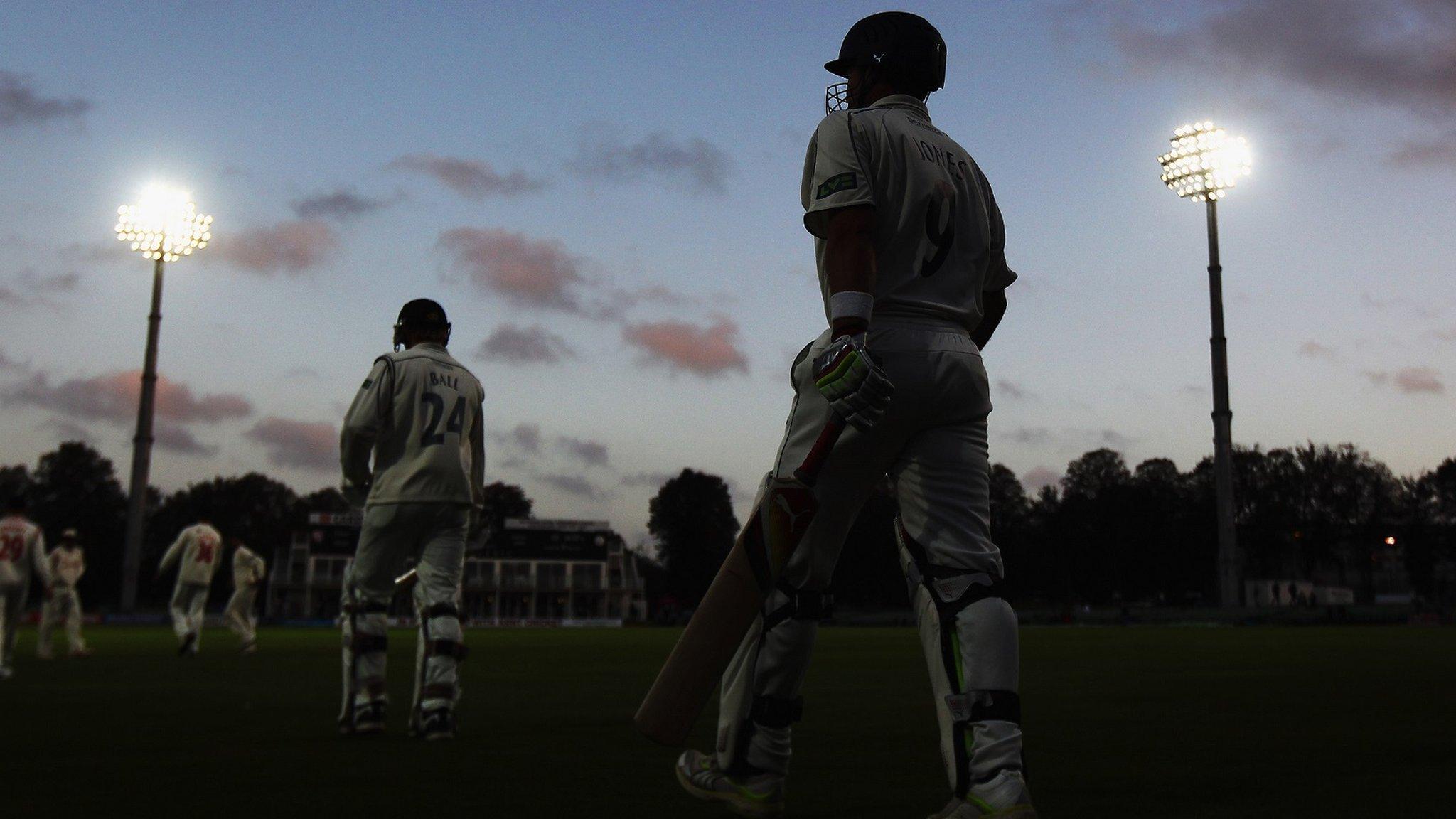County Championship: How the opening day of day-night matches unfolded
- Published
- comments
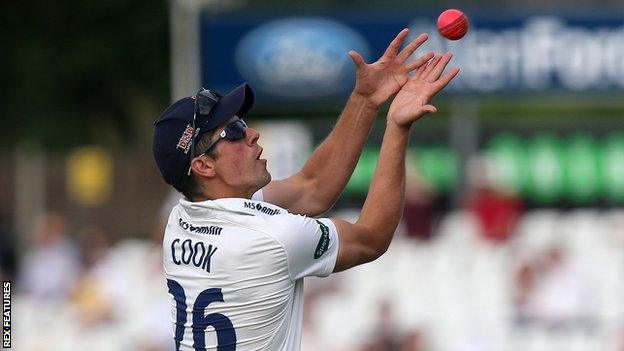
Former England Test captain Alistair Cook was one of a number of international stars on show on Monday
Monday saw the beginning of the first-ever round of day-night fixtures to be played in the County Championship - and it was not short of talking points.
In total, 2,984 runs were scored and 96 wickets fell across the nine matches taking place in Divisions One and Two, with England's Test players also in on the action.
BBC Sport takes a closer look at how the opening day of pink-ball cricket in England and Wales played out.
Did the crowds match the hype?
"First things first, this round of matches is about England players preparing for day-night Test cricket, rather than boosting the health of the county game," said BBC Sport's Stephan Shemilt, who was watching Warwickshire against Lancashire at Edgbaston.
"Any impact on the crowd would be incidental, but it would be encouraging to see greater numbers through the gates. Here, that was not the case.
"There was no noticeable difference in attendance when compared to a normal Championship match. It was free to get in for the final session but, instead of people arriving after work, the crowd thinned. The weather may have played a part in that."
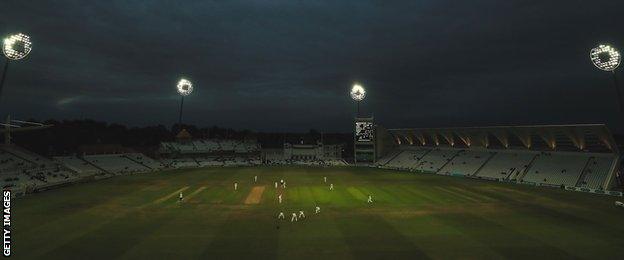
BBC Radio Nottingham's Dave Bracegirdle said Trent Bridge had hosted "a pretty decent crowd all day"
Edgbaston was not alone in seeing the crowd diminish rather than increase, as was hoped, during the final session - despite some grounds offering free and reduced-price entry.
BBC Radio London's Kevin Hand at Chelmsford and BBC Radio Solent's Kevan James at Southampton both reported a reduced number of spectators after the last interval, although BBC Radio Newcastle's Martin Emmerson said the crowd at Durham was "a bit bigger and certainly noisier than usual".
How did the pink ball behave?
Across the nine matches, there appeared to be more concern over the visibility of the pink ball for spectators and fielders than for the batsmen - and any additional movement compared to the red ball seemed negligible.
This is arguably backed up by the number of wickets to fall. So far this season, Division One matches have seen an average of one wicket every 11 overs on the opening day of matches, while on Monday a wicket came on average every 10.3 overs.
"I would say it was very similar to the red ball," explained BBC Radio Northampton's Alex Winter. "It just depended on the overheads.
"There was a little early swing in the daytime and the Leicestershire bowlers did find some movement with the older ball. But, in the final session with the lights taking good effect, there was much more movement than with the new ball earlier in the day.
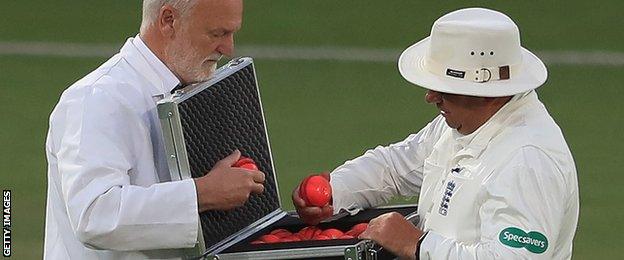
BBC local radio commentators reported that, when a new pink ball was taken, it was much easier to pick out
"To begin with the new pink ball was better to pick out than the red but towards the 50-over mark, with no floodlights on, it became quite hard to pick up.
"When the floodlights came on, it shimmered in the lights like the white ball never does - but it was still difficult until the floodlights took full effect very late in the day."
BBC Radio London's Mark Church also highlighted the very noticeable change when the new ball was taken during the final session, saying that "it almost looks like it's come out of a toy shop," such was the difference in brightness and clarity between the two.
Kevin Howells, commentating at Headingley, even said on BBC Radio 5 live there had been some suggestions that, after about 20 overs, the ball not only becomes duller and softer but also gets bigger because it retains moisture.
How did England's stars fare under the lights?
With a full contingent of England players in action this week - aside from injured Nottinghamshire seamer Stuart Broad - much of the attention has centred around how the international stars would perform in alien conditions.
Essex opener and former Test captain Alastair Cook continued his imperious domestic form, compiling another confident 64 not out for the Division One leaders.
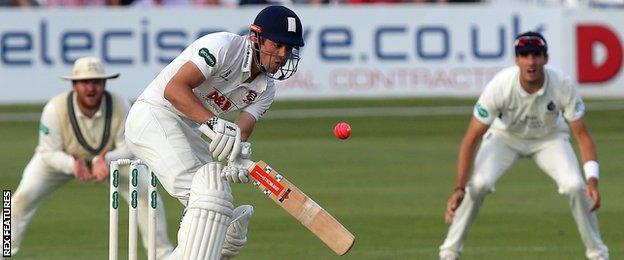
Alastair Cook has been in fine form this season, with his County Championship average standing at 59.77
But the problem of who should partner him at the top of England's order still appears unsolved, with Lancashire's Haseeb Hameed and Durham's Keaton Jennings again struggling with modest scores of 17 and six.
All-rounder Ben Stokes also endured a disappointing day at Chester-le-Street, making a seven-ball duck, while Jos Buttler was dismissed for just two despite being promoted to number three for Lancashire.

Jason Roy was making his first County Championship appearance of the season for Surrey - and struck 87
Elsewhere, Northants' Ben Duckett blasted 112 - his century coming from just 89 deliveries in the first session - and white-ball specialist Jason Roy clobbered 87 from 91 balls for Surrey against Yorkshire.
With the ball, fast bowler Mark Wood took 3-30 while the rest of the Durham attack struggled against Worcestershire.
Who else caught the eye?
Domestic cricket history was also made in Glamorgan's game with Derbyshire in Cardiff, with the visitors naming 16-year-old Afghan-born spinner Hamidullah Qadri in their team, making him the first player born in the 2000s to play Championship cricket.
Division One leaders Essex also handed a debut to Pakistan fast bowler Mohammad Amir - and he followed his performance in the Champions Trophy with 2-53 against Middlesex.

Mohammad Amir played a starring role in Pakistan's recent Champions Trophy success
What did the players think?
Yorkshire's Tim Bresnan told BBC Radio Leeds: "It was a kind of weird day. It nipped around with the new ball and we thought 'if it keeps doing this, we've got half a chance'. Then it stopped.
"When the ball got really soft, it was difficult and looked easy-paced. It was quite slowish. I don't think the light played as much of a factor as we expected it to."
Surrey's Jason Roy told BBC Radio London: "We saw it doing a little bit more than expected in the evening. But, apart from that, everything was pretty standard.
"It was just a different colour, everything else was pretty similar. You could see when the lights came on, the ball was like a lightbulb. It was extremely shiny and the boys had to get to grips with that. After three, four, five overs it died down."
Hampshire all-rounder Liam Dawson told BBC Solent: "The crowds haven't changed. We haven't had any more people in. But it is early days and it is something that might work.
"From my first experience of it, they need to have a good look at what balls they are going to use. If you are going to keep on using those balls then you are going to get some pretty boring cricket."
Lunch? Tea? Supper?
One of the major - albeit more trivial - talking points on Monday was what the intervals should be called, with breaks at 16:00 and 18:40 not particularly befitting of the titles 'lunch' and 'tea'.
In Australia, where three day-night Tests have already been played, they are called 'tea' and 'dinner'.
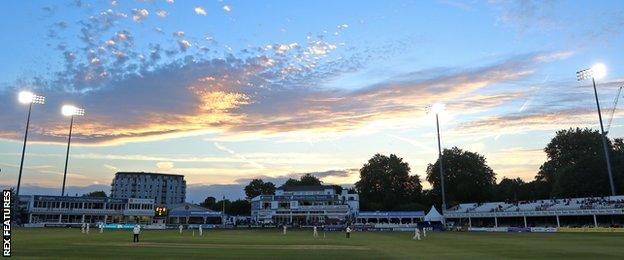
There was a picturesque sky during the final session at Chelmsford - but what should the sessions be called?
'Afternoon tea', 'high tea' and 'supper' were all put forward by readers of the BBC Sport live text commentary page - while 'tiffin' was one suggestion made by BBC Radio Kent's Ben Watts.
Even our scorecards were bamboozled for a short period during the second interval, temporarily crashing before normal service was resumed for the final session.
What's the background?
England will play their first home day-night Test against West Indies at Edgbaston from 17-21 August - and will also play a day-night Test in Adelaide in December as part of the 2017-18 Ashes series against Australia.
"It was important for us to arrange a full round of fixtures to give our England players the chance to experience the conditions," said ECB chief executive Tom Harrison, when the Championship plan was announced last November.
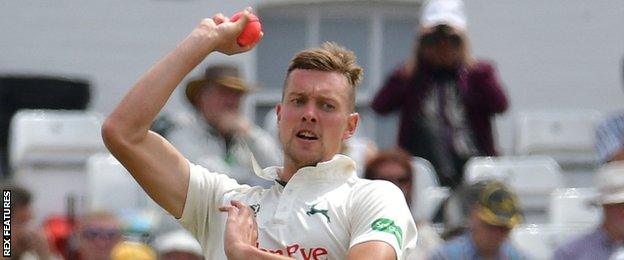
Nottinghamshire seamer Jake Ball will hope to be involved in England's day-night Test against the West Indies
"But, just as we wanted to assess the impact of making Test cricket more accessible by changing the hours of play, the counties have really embraced the potential of Championship matches that stretch well into the evening when people have finished school or work."
The ECB will not make any firm decision on whether to schedule a similar round of day-night fixtures in 2018 until they have received feedback from the counties about this season's round of games.
The County Championship has actually played host to day-night cricket in the past - a one-off fixture between Kent and Glamorgan at Canterbury in 2011.
That game took place late in the season in September and, despite free entry for the final 'night' session, attendances were poor and the experiment received a mixed response from players.
- Published22 June 2017
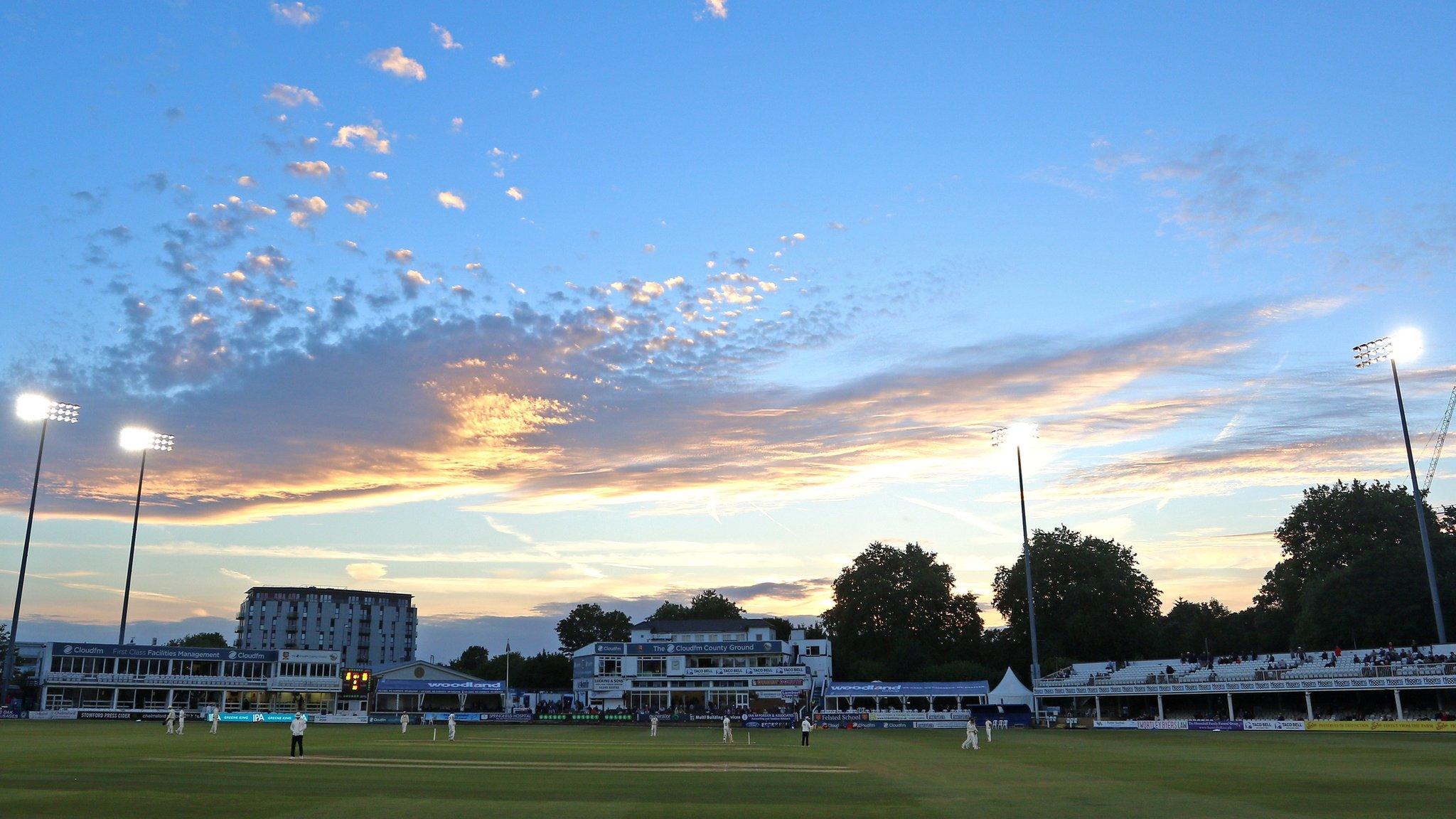
- Published25 June 2017
